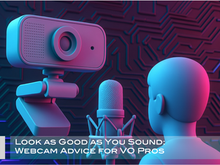Stop Slamming the Gate! A Voice Actor’s Guide to Cleaner Audio
- Frank Verderosa
- Aug 9
- 3 min read
Updated: Sep 22

It’s no secret that, as an audio engineer, I’d much rather voice actors leave their raw sound alone. I’ve seen too many talented performers throw good money at bad solutions, hoping to “polish” their audio—only to make it worse.
One tool that comes up more often than you’d think? Noise gates. And while they have their place in the world of audio, that place is almost never in your voiceover chain.

What a Noise Gate Actually Does
Let’s break it down simply.
A noise gate works like an automated mute button. It listens to your audio, and the moment your volume drops below a certain threshold, it “closes” the gate—muting the sound entirely. When your voice comes back in and crosses that threshold, it “opens” again.
In music production, noise gates can be super helpful. For example:
On a drum kit, to cut out the cymbal bleed in the tom mics between hits.
On a guitar amp, to kill the buzzing when the guitarist isn’t playing.
On live vocals, to reduce stage noise in quiet moments.
In these contexts, the gate is hiding sounds you don’t want in between the moments you do want.

Why Noise Gates Don’t Work for Voiceover
The problem in voiceover is that your performance is one continuous piece of storytelling. If you clamp down on the audio between words and sentences, it doesn’t sound natural—it makes the background noise “breathe” in and out.
And that’s actually worse.
I worked on a recent job with a remote voice actor whose background noise was way too high. To try to hide it, they muted themselves between takes. Unfortunately, this only made the noise more noticeable when it popped back in again. Noise gates create the same problem: the sudden “dead silence” between words draws attention to the issue instead of hiding it.

Better Tools for the Job
When I’m mixing voiceover, I have a lot of tools to choose from—and they’ve only gotten better over time. If you really need to clean up audio, there are far more transparent options than a noise gate.
Some of my go-to noise reduction tools include:
[iZotope RX Voice De-Noise] – Dynamically removes steady background noise while you speak and between words, without that unnatural on/off sound.
[iZotope RX De-click] – Targets mouth clicks and other small pops that can be distracting in narration.
[Waves Clarity VX] – AI-powered noise reduction that intelligently separates your voice from background noise with minimal artifacts.
The difference? These tools work within the performance, cleaning as you go, rather than chopping up the audio into awkward silent chunks.

Start at the Source
Even with great tools, I always stress this in my RX Elements classes: use them sparingly, tastefully, and as a last resort. Your first priority should always be reducing noise at the source.
That might mean:
Improving your recording space with proper treatment.
Choosing a quieter recording time.
Adjusting mic placement and gain settings.
Let’s Get Your Audio Right
If you’re unsure whether your home setup has noise issues—or if you want to learn best practices for cleaning up your sound—I offer one-on-one evaluation sessions where we can pinpoint problems and fix them.
And if you want to dive deeper, stay tuned for my next round of classes, where we take a no-BS approach to making you sound your best—without overprocessing your performance.






























Terrific article Frank. Very clarifying, really enjoyed it.